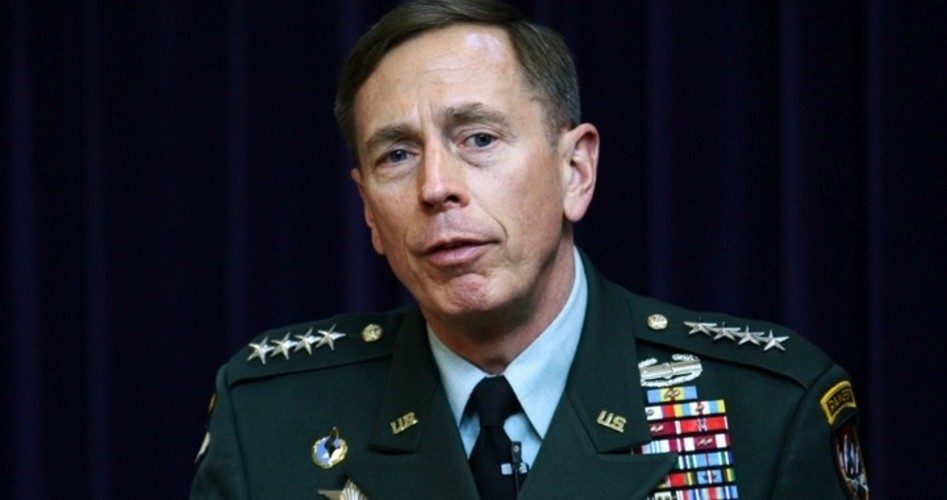
“Why do the powerful cheat?” That is the headline of an article published by USA Today reporting on the alleged extramarital affair carried on by CIA Director General David Petraeus that resulted in his resignation.
That is a sociologically interesting question regarding the lives of eminent men, but a more important question to the political life of our Republic is why powerful men such as Petraeus and his recently reelected boss cheat on their oaths of office to preserve, protect, and defend the Constitution.
Arguably, it was Petraeus’ pursuit of a more overtly military role for the intelligence agency that will be his most devastating legacy.
As Robert Wright says in an Atlantic article:
When, in the fall of 2011, David Petraeus moved from commanding the Afghanistan war effort to commanding the CIA, it was a disturbingly natural transition. I say “natural” because the CIA conducts drone strikes in the Afghanistan-Pakistan region and is involved in other military operations there, so Petraeus, in his new role, was continuing to fight the Afghanistan war. I say “disturbingly” because this overlap of Pentagon and CIA missions is the result of a creeping militarization of the CIA that may be undermining America’s national security.
This trend was clear during the Bush administration, but it accelerated under President Obama, who greatly expanded drone strikes, and it reached a kind of symbolic culmination when Obama nominated this four-star general to run things at Langley. That would have been the perfect time to reflect on the wisdom of the convergence of the CIA’s and Pentagon’s jobs. But, instead, the network of journalists, think tankers, public officials and others who constitute the foreign policy establishment preserved their nearly unblemished record of not focusing on the biggest questions.
An example of this acceleration of the CIA’s role in military operations was provided in a Wired magazine report that 333 drone strikes have been carried out in Afghanistan this year. Notably, the lead on carrying out these attacks has been assumed by the CIA under Petraeus’ watch. The Wired story reports:
“The difference between the Afghan operation and the operations in Pakistan and elsewhere come down to the fundamental differences between open military campaigns and covert campaigns run by the intelligence community. It shapes everything from the level of transparency to the command and control to the rules of engagements to the process and consequences if an air strike goes wrong,” e-mails Peter W. Singer, who runs the Brookings Institution’s 21st Century Defense Initiative. (Full disclosure: I have a non-resident fellowship there.) “This is why the military side has been far less controversial, and thus why many have pushed for it to play a greater role as the strikes slowly morphed from isolated, covert events into a regularized air war.”
The military has 61 Predator and Reaper “combat air patrols,” each with three or four robotic planes. The CIA’s inventory is believed to be just a fraction of that: 30 to 35 drones total, although there is thought to be some overlap between the military and intelligence agency fleets. The Washington Post reported last month that the CIA is looking for another 10 drones as the unmanned aerial vehicles (UAVs) become more and more central to the agency’s worldwide counterterror campaign.
Increasing the CIA’s arsenal of drones, as well as its approved theatre of operations, was a priority of Petraeus. As we reported last month, CIA Director and retired Gen. David Petraeus (a member of the internationalist Council on Foreign Relations) insisted that a beefed-up drone presence would help his agents keep up with the “threats in North Africa,” a region the government insists is attracting al-Qaeda militants fleeing from the constant barrage of Hellfire missiles fired from drones patrolling the skies over Pakistan and Yemen.
It’s not as if North Africa hasn’t seen its share of drone sorties. On July 24, the Washington Post published an article describing the congestion of the skies over Somalia caused by drone traffic. The situation is so bad, says the Post, that there is a “danger to air traffic” in the area.
An additional problem posed by the proliferation of the unmanned aircraft above the east African nation is that their presence might be evidence of a violation of a 1992 United Nations Security Council arms embargo still in effect.
The article in the Post cites a UN report in which officials of the international body recount several instances where collisions between drones and commercial aircraft or objects on the ground were “narrowly averted.” One such incident involved a drone and a passenger plane flying above Mogadishu, the capital of Somalia.
The authors of the report of the investigation did not directly implicate the United States. That said, the report indicated that “at least two of the unmanned aircraft appeared to be U.S.-manufactured and suggested that Washington has been less than forthcoming about its drone operations in Somalia.”
According to the report, there have been 64 unauthorized drone deployments, fighter jet missions, or attack helicopter flights recorded in Somalia since June 2011. At least 10 of the documented flights involved drones.
While the U.S. military keeps mum about its use of drones around the world, it is known that drones are deployed and launched from American military bases in Djibouti, the Seychelles, and Ethiopia. In fact, in a statement released in June, the Obama administration admitted that it “is engaged in a robust range of operations to target Al-Qaeda and associated forces, including in Somalia.” In 2011, the military acknowledged that as part of that operation a drone strike was launched against two suspected leaders of al-Shabaab, an alleged al-Qaeda affiliate based in Somalia. Again, the use of these drones and the firing of missiles at militants seemingly violates the 1992 embargo, as drones carrying Hellfire missiles are inarguably deployed for uses that are “exclusively military,” in direct contravention of the terms of the embargo.
Ultimately, the decision of whether to ship additional drones to the CIA will be made by “a group led by President Obama’s counterterrorism adviser, John O. Brennan,” according to officials cited in the Washington Post article. In other words, more powerful men who will commit to violating their vows to uphold the Constitution.
This group is reportedly the same powerful cabal that decides which names get added to the president’s infamous “kill list” and how soon those targets are erased from the list by way of a presidential order of summary execution. No charges. No trial. No problem.
Again, from Robert Wright,
The circumstances of Petraeus’s departure from the CIA are a little alarming; you’d rather your chief spy not be reckless. But the circumstances of his arrival at the CIA a year ago were more troubling. Yet no alarm was sounded that was anywhere near as loud as the hubbub surrounding Petraeus now. That’s scandalous.
While the fallout from General Petraeus’ supposedly sordid personal life and his alleged failure to remain faithful to his wife will occupy the time and ink of the mainstream media, there should be greater interest on the infidelity of so many powerful men who have succumbed to the siren call of unrestrained power and have abandoned their commitment to due process, the rule of law, and constitutional limits on authority.



